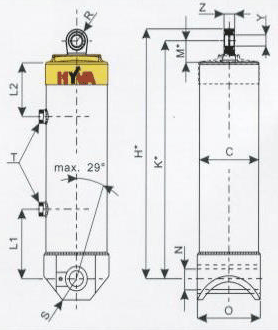What is the Difference Between a Single & Double Acting Cylinders?
And How Do I Know Which Cylinder Is Right For My Project?
There are two main type of hydraulic cylinders, a single acting cylinder and a double acting cylinder, the two function very differently when it comes to the hydraulic fluid that is contained within, but what is the actual difference between the two – and how do you know which one is right for your machinery and equipment?
Single Acting Hydraulic Cylinders:
A single acting hydraulic cylinder is unique in the fact that the fluid within the mechanism only applies pressure onto one side of the piston. That pressure forces the cylinder shaft to extend creating that movement. The fluid within the cylinder is oil, preventing the cylinder from compressing. Depending on the single acting cylinder, the oil will either be forwarded into a separate reservoir or the other option is that by means of a small device, the oil will flow back automatically. This simple process is extremely effective when it comes to equipment and various devices, and is used by people around the world to simplify tasks that otherwise might be extremely challenging tasks. In short, a single acting cylinder only functions by means of pressure to one side, then retracts by another outside source such as the weight of the load, or commonly a spring.

Double Acting Hydraulic Cylinders:
A double acting cylinder functions a little bit differently from a single acting cylinder. In this type of hydraulic cylinder, hydraulic fluid is used to utilize pressure onto both sides of the piston permitting for both extension and compression with no help from any sort of spring, crank, or device. The double acting cylinder is not utilized in as many situations, but only when extreme force is needed in both extension and retraction of a device.
Now, when it comes to understanding which cylinder is correct when it comes to your piece of equipment, engine, or application, it’s important to understand what situations call for which cylinders! Single acting cylinders are simpler in design and are more compact making them versatile for many different situations. Although simple and versatile, the single acting cylinder also has some disadvantages when it comes to size and it’s force ability because it can only really provide a large amount of force one way. Whereas a double acting cylinder, although it is larger, and isn’t as compact, will provide a sort of power and force that is unmatched by the single-acting cylinder.
Examples of Single Acting Cylinders: Most car & diesel engines
Examples of Double Acting Cylinders: Steam Engines
This is just a brief overview of how single and double acting cylinders differ as well as the various applications that you might use them for. If you are unsure about which cylinder will serve best for your project, please Contact Us here at All Phase Hydraulics. We would be happy to help you find which cylinder will be best for you.


